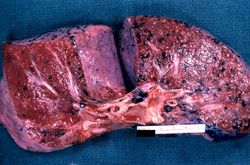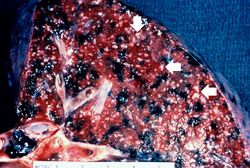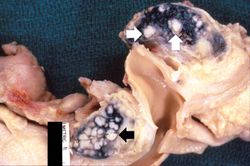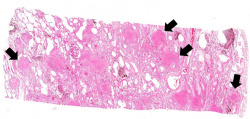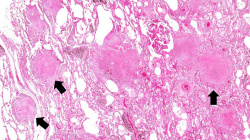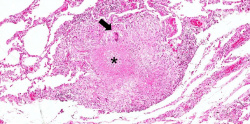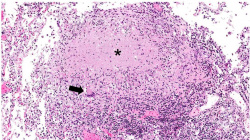Difference between revisions of "IPLab:Lab 1:Tuberculosis"
(→Autopsy Findings) |
(→Images) |
||
| Line 9: | Line 9: | ||
File:IPLab1Tuberculosis2.jpg|This is a closer view of the same section of lung containing multiple white granulomas which are now more easily identified (arrows). These lesions are referred to as miliary tuberculosis. Dark areas of anthracosis are also prominent in this lung. | File:IPLab1Tuberculosis2.jpg|This is a closer view of the same section of lung containing multiple white granulomas which are now more easily identified (arrows). These lesions are referred to as miliary tuberculosis. Dark areas of anthracosis are also prominent in this lung. | ||
File:IPLab1Tuberculosis3.jpg|This gross photograph shows hilar lymph nodes from another patient with disseminated tuberculosis. The white, cheesy-appearing nodules (arrows) in the lymph nodes give rise to the descriptive terminology of caseous necrosis. The black pigment in the lymph nodes is anthracotic pigment that has drained from the lungs. | File:IPLab1Tuberculosis3.jpg|This gross photograph shows hilar lymph nodes from another patient with disseminated tuberculosis. The white, cheesy-appearing nodules (arrows) in the lymph nodes give rise to the descriptive terminology of caseous necrosis. The black pigment in the lymph nodes is anthracotic pigment that has drained from the lungs. | ||
| − | File: | + | File:IPLab1Tuberculosis4b.jpg|This is a low-power photomicrograph of a histology section from the lung of this patient with a chronic history of respiratory disease. Note the multiple eosinophilic nodules (arrows) seen at low power in this section. Other areas of the lung are relatively normal and several bronchi and large vessels can be seen at this low power. The pleural surface of the lung is at the right and the remaining edges are cut edges of the tissue block. |
| − | File: | + | File:IPLab1Tuberculosis5b.jpg|This higher-power photomicrograph of the eosinophilic nodules (arrows) illustrates their discreet nature and the surrounding inflammatory response in the remaining normal lung tissue. |
| − | File: | + | File:IPLab1Tuberculosis6b.jpg|This photomicrograph shows a single nodule with an amorphous eosinophilic center and accumulations of cells around the outer edge. This is typical of a granuloma associated with tuberculosis in which there is a necrotic center (*) and a rim of lymphocytes, macrophages, and a multinucleated giant cell (arrow) around the periphery. |
| − | File: | + | File:IPLab1Tuberculosis7b.jpg|This is a higher-power view of a granuloma with the amorphous eosinophilic material representing caseation necrosis (*), a giant cell (arrow), and inflammatory cells around the periphery. |
| − | |||
</gallery> | </gallery> | ||
Latest revision as of 22:09, 27 June 2019
Contents
Clinical Summary[edit]
This 70-year-old man was admitted to the hospital with a three week history of upper abdominal pain, anorexia, nausea, and general malaise. His hospital stay was characterized by fever and severe respiratory distress. There were multiple densities in the patient's chest x-ray consistent with pneumonia and examination of a stained sputum specimen showed acid fast bacilli. Despite appropriate therapy, the patient died 14 days after admission.
Autopsy findings demonstrated pulmonary tuberculosis with widespread dissemination throughout the body. Multiple gray-white nodules ranging from pinpoint size up to 1 cm were diffusely distributed throughout the lung parenchyma.
Images[edit]
This is a gross photograph of a cut section of lung from this patient with disseminated tuberculosis. The numerous small white nodules scattered throughout this lung tissue represent individual tuberculosis granulomas. In addition, note the dark areas throughout the lung which represent deposits of anthracotic pigment.
This gross photograph shows hilar lymph nodes from another patient with disseminated tuberculosis. The white, cheesy-appearing nodules (arrows) in the lymph nodes give rise to the descriptive terminology of caseous necrosis. The black pigment in the lymph nodes is anthracotic pigment that has drained from the lungs.
This is a low-power photomicrograph of a histology section from the lung of this patient with a chronic history of respiratory disease. Note the multiple eosinophilic nodules (arrows) seen at low power in this section. Other areas of the lung are relatively normal and several bronchi and large vessels can be seen at this low power. The pleural surface of the lung is at the right and the remaining edges are cut edges of the tissue block.
This photomicrograph shows a single nodule with an amorphous eosinophilic center and accumulations of cells around the outer edge. This is typical of a granuloma associated with tuberculosis in which there is a necrotic center (*) and a rim of lymphocytes, macrophages, and a multinucleated giant cell (arrow) around the periphery.
Virtual Microscopy[edit]
Lung: Tuberculosis[edit]
Normal Lung[edit]
Study Questions[edit]
Additional Resources[edit]
Reference[edit]
- eMedicine Medical Library: Tuberculosis
- Merck Manual: Tuberculosis
- Centers for Disease Control: Tuberculosis
Journal Articles[edit]
- Lee MP, Chan JW, Ng KK, Li PC. Clinical manifestations of tuberculosis in HIV-infected patients. Respirology 2000 Dec;5(4):423-6.
Images[edit]
Related IPLab Cases[edit]
| |||||
In alcoholics, aspiration pneumonia is common--bacteria enter the lung via aspiration of gastric contents.
Acid fast bacilli are not easily decolorized by acid during staining. This is characteristic of mycobacteria.
Disseminated tuberculosis refers to the hematogenous spread of tuberculous lesions throughout the body. It is also known as miliary tuberculosis (which is so-called because the lesions resemble millet).
A tuberculosis granuloma is a focus of granulomatous inflammation caused by CHRONIC tuberculosis infection. The granuloma consists of epithelioid cells (activated macrophages) surrounded by lymphocytes, plasma cells, and fibroblasts.
Anthracotic pigment is coal dust deposited in the lungs--it is seen in coal miners, city-dwellers, and smokers.
Disseminated tuberculosis refers to the hematogenous spread of tuberculous lesions throughout the body. It is also known as miliary tuberculosis (which is so-called because the lesions resemble millet).
Caseous means cheesy.
